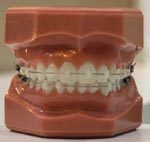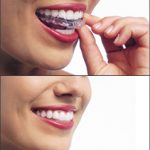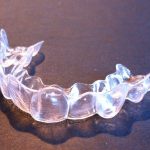Orthodontics
We have a wide array of orthodontist braces and other orthodontics in order to meet your various needs. Dental braces are often used to correct the following situations: underbites, malocclusions, overbites, cross bites, open bites, deep bites, crooked teeth, and various other flaws of the teeth and jaw.
 It is recommended that children by the age of 7 receive an orthodontic evaluation. Straightening or moving the teeth into better positioning can improve the bite and protect teeth from sustaining damage.
It is recommended that children by the age of 7 receive an orthodontic evaluation. Straightening or moving the teeth into better positioning can improve the bite and protect teeth from sustaining damage.
Recently, braces are becoming more popular among adults. In fact, children often must wait until their permanent teeth to come in before treatment will do any good. There are a number of orthodontic appliances, such as plates that can be removed for cleaning. Other functional appliances are also used to change the way the jaw is growing. Brackets and flexible wires are temporarily placed to the teeth for that purpose.
The advent of plastics and ceramics offer more attractive choices. There are even invisible braces made from tough, clear plastic. These “aligners” must be worn at least 22 hours per day to be effective only being removed to eat and clean the teeth. After a couple of weeks these molds are then replaced with the next progressive set. The popular “Invisalign” braces work very well for adults.
Traditional braces are made up of metal brackets that are carefully placed onto the enamel of each tooth using a strong adhesive. Each bracket is connected to a metal wire that runs across your teeth giving pressure that gradually works to straighten your teeth.
Invisalign braces are a custom set of clear aligners that work like traditional braces to straighten teeth. With Invisalign braces, there are no embarrassing brackets or wires attached to your teeth. The system is actually a series of trays that will fit over your teeth. Each tray will make a slight adjustment to your teeth until perfect alignment is achieved. An Invisalign aligner will be virtually unnoticeable by the naked eye and patients will be able to go about your daily routine feeling confident and self-assured. They are the preferred choice for adults who want straightened teeth and do not want to be bothered by the hassle of traditional braces.
RETAINERS
Orthodontic retainers are custom-made devices, usually made of wires or clear plastic, that hold teeth in position after surgery or any method of realigning teeth. Once a phase of orthodontic treatment has been completed to straighten teeth, there remains a lifelong risk of relapse (a tendency for teeth to return to their original position) due to a number of factors: recoil of periodontal fibres, pressure from surrounding soft tissues, the occlusion and patient’s continued growth and development. By using retainers to hold the teeth in their new position for a length of time, the surrounding periodontal fibres are allowed to adapt to changes in the bone which can help minimize any changes to the final tooth position after the completion of orthodontic treatment.
 Retainers can be removable or fixed; removable retainers are only required to be worn part-time (at night) and that overall there is still insufficient evidence to recommend one type of retention procedure over another.
Retainers can be removable or fixed; removable retainers are only required to be worn part-time (at night) and that overall there is still insufficient evidence to recommend one type of retention procedure over another.
